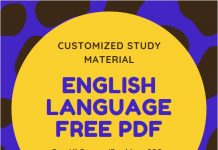 For Daily Job Alert For Daily Job Alert |
Join Our Whats App Channel |
 For Free Study Material For Free Study Material |
Join Our Telegram Channel |
Passage & Paragraph Inference Tips & Tricks
What Are Inference Questions?
Inference questions ask about the meaning of a line, paragraph, or even an entire passage. The ideas being asked about are not directly stated in the text, which mean that inference questions often include the phrases “could be interpreted to mean” or “suggests that.” Since there can only be one correct answer to any Exams question, however, the answers to these questions cannot be subjective or ambiguous.
 Via funnyworld.info.
Via funnyworld.info.
Inference questions often also require big picture skills, since you must be able to get meaning from entire passages to answer questions about paired passage relationships, or from entire paragraphs for other inference questions. In contrast to function questions, which ask “what does [this word, phrase, or line] DO,” inference questions ask “what does [this word, phrase, or line] MEAN?”
There are three main kinds of inference questions: deduction, speculation, and examination.
Type 1: Deduction
Inference questions that fall into this subcategory ask you to fill in missing information. The gist of most of the questions is “If something is said in the passage, what is the logical extension?”Deduction questions are very close to detail questions, except that you must make a logical deduction, rather than relying only on information in the passage. For example:
According to the passage, Woolf chooses the setting of the bridge because it
The relevant lines:
Close at hand is a bridge over the River Thames, an admirable vantage ground for us to make a survey. The river flows beneath; barges pass, laden with timber, bursting with corn; there on one side are the domes and spires of the city; on the other, Westminster and the Houses of Parliament. It is a place to stand on by the hour, dreaming. But not now. Now we are pressed for time. Now we are here to consider facts; now we must fix our eyes upon the procession — the procession of the sons of educated men.
To get the correct answer, (B), you must deduce from the info given. My thoughts:
Normally we’d be on the bridge to dream and have fanciful reflection, but that’s not the case now. Instead, now we have to do something else while standing on the bridge. What is that something else? Fixing our eyes on the procession of the sons of educated men.
There will be a more full walkthrough of an inference question later on in this article – the point of that was to show the eensy, teensy step you have to take beyond what is written to answer inference questions. It’s not like high school English literature classes, where you’re encouraged to make any interpretation you can, as long as you can back it up with enough words/rambling. In fact, I know that some people just think of these kinds of inference questions as paraphrasing, becaus so little interpretation is involved.
Some examples of how these questions have been asked on the Exams (with some modifications to keep them on the same theme):
- Based on the passage, the authors’ statement “If a pair consisted of two piccolos, for example, there would not be room for it” (lines 29-30) implies that a pair
- The narrator implies that Ms. Boulanger favors a form of education that emphasizes
- In Passage 1, Bach contends that breaking the laws of counterpoint has which consequence?
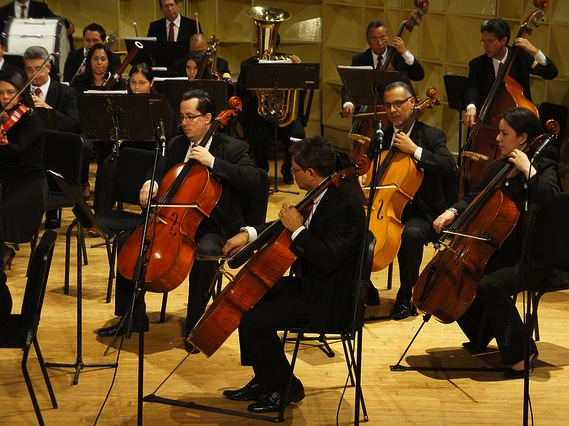 La Orquestra Filharmónica Nacional entonó el Himno Nacional y la canción Patria Querida by Luigino Bracci, used under CC BY 2.0/Cropped from original.
La Orquestra Filharmónica Nacional entonó el Himno Nacional y la canción Patria Querida by Luigino Bracci, used under CC BY 2.0/Cropped from original.
From my constant comments about musicians, you may be able to DEDUCE that I, too, am a musician.
Type 2: Speculation
These inference questions ask you to speculate about the meaning (or “suggested” meaning) of a statement, description, or something else in the passage. In some ways, these are similar to function questions, but the answers the Exams is looking for are very different. Take this question:
In the passage, Akira addresses Chie with
If this were a function question, the answer choices would be generic, like “a continuation of an extended comparison” or “an unexpected answer to a question.”
Since this is an inference question, the answer choices are more specific, along the lines of “affection but not genuine love” or “amusement but not mocking disparagement.”
Some examples of how this sort of inference question is asked:
- It can reasonably be inferred that “the strong-minded” (line 32) was a term generally intended to
- In line 42, the authors state that a certain hypothesis “can best be tested by a trial.” Based on the passage, which of the following is a hypothesis the authors suggest be tested in a trial?
- The phrase “liquid gold” (line 71) most directly suggests that
- What does the author suggest about the transgenic studies done in the 1980s and 1990s?
Type 3: Examination
Inference questions which fall into the examination subcategory question you about the internal life (thoughts, feelings, motivations) of the narrator, author, or someone mentioned in the passage. They can mostly be summed up as asking “What would [this person] think about [that thing]?” Examination questions are the most complicated type of inference questions, because they ask you to get into the head of the author/narrator/character/other person mentioned in the text. You will often see these sorts of questions on paired passages.
Fortunately, it is pretty easy to identify examination inference questions, since they do tend to fall into “what does X think about Y” format. See below for some examples:
- The “social psychologists” mentioned in paragraph 2 (lines 17-34) would likely describe the “deadweight loss” phenomenon as
- The passage indicates that when the narrator began working for Edward Crimsworth, he viewed Crimsworth as a
- It can be inferred that the authors of Passage 1 believe that running a household and raising children
- It can most reasonably be inferred from Passage 2 that Paine views historical precedents as
- Beecher would most likely have reacted to lines 65-68 (“Now . . . woman”) of Passage 2 with
6 Superior Strategies for Attacking Inference Questions
So how do you attack inference questions? Is there any way other than just reading the entire passage? (Answer to the first question: hold on one moment. Answer to that second question: yes, for sure)
I’ve compiled for you a bunch of different strategies for attacking inference questions. Some of these strategies work better if you read the passage a certain way (for instance, looking for context may not be as necessary for students who read the passage all the way through), but much of the advice is useful no matter what your method of reading the passage.
Strategy 1: Understand What The Question Is Really Asking
Understanding what an inference question is actually asking can be hard to wrap your head around, particularly when they ask about multiple passages. Questions are often wordy and seem to require a lot of information before you can even begin to answer them. For instance:
B) will be difficult to bring about in the absence of regulations.
C) cannot be attained without technologies that do not yet exist.
D) seems certain to affect Earth’s economy in a negative way.
This question requires you to find information about the future of space mining in Passage 1 and then put yourself in the shoes of the author of Passage 2 and figure out what that author would think about the topic …ugh.
 Aches and pains by Quinn Dombrowski, used under CC BY-SA 2.0/Cropped from original.
Aches and pains by Quinn Dombrowski, used under CC BY-SA 2.0/Cropped from original.
How do you answer this kind of question without causing your brain to hurt too much? You break it down, piece by piece, into a question that is answerable.
For the example above, you have to start by figuring out what the future of spacing mining says in Passage 1. How? Look at the sentence(s) referenced in the question (sometimes the quoted word may actually refer to something in another sentence, but I’ll go into that later). In this case, the author of Passage 1 claims that not only will space miners might “[meet] earthly demands for precious metals…and the rare earth elements,” “enrich themselves,” but they will also “build an off-planet economy free of any bonds with Earth.” Now all you have to do find specific places in Passage 2 where the author talks about the implications of space miners meeting demand for elements rare or valuable on earth (vaguely referenced in lines 48 and 51), getting rich themselves (specifically mentioned in lines 57-66), or creating an off-world economy (mentioned in lines 73-78).
As you can see, figuring out what an inference question is asking can get you most of the way to figuring out what the answer is. Let’s look at the example from above again, keeping the three topics discussed in lines 18-28 in mind.
B) will be difficult to bring about in the absence of regulations.
C) cannot be attained without technologies that do not yet exist.
D) seems certain to affect Earth’s economy in a negative way.
To find the answer to this question, use the process of elimination on the answer choices. Do any of the parts of Passage 2 that address the claims in lines 18-28 of Passage 1 support the choices?
Choices C) and D) can be eliminated immediately because Passage 2 does not make either of these claims at all, which leaves you with a choice between choices A) and B). While the authors of Passage 2 posit that “Others will suggest glutting ourselves on space’s riches is not an acceptable alternative to developing more sustainable ways of earthly life,” they do not make any claims about the sustainable use of space resources, which means that choice A) is wrong.
By contrast, after mentioning that “the relevant legal and regulatory framework” for space mining “is fragmentary, to put it mildly” in lines 73-78, the author of passage 2 concludes that “…miners have much to gain from a broad agreement on the for-profit exploitation of space. Without consensus, claims will be disputed, investments risky, and the gains made insecure.” This directly discusses regulation of space mining and how it would be difficult to move forward with space mining in the absence of regulation, making the correct answer to this question choice B).
Strategy 2: Look For Context
Exams Reading may lull you into a sense of false security, because line numbers are given in a question (so you clearly don’t have to look elsewhere). WRONG! The lines present in the question (particularly when it is an inference question) are not necessarily the only lines you’ll need to answer the question – often, more context is needed.
If you’re having trouble with an inference question because the lines cited aren’t enough, the best strategy is to look at the sentences before and after the phrase/sentence/lines you’re given in the question. Sometimes even that isn’t enough, and you’ll need to know the main point of the passage or the perspective of the author in order to properly answer an inference question. Don’t panic if this is the case – if you’re struggling to answer the question, mark it in your test booklet and come back to it after you’ve answered other relevant questions (like questions about the paragraph/section the lines in question are in, or even questions about the whole passage).
Strategy 3: Answer In Your Own Words
For me, this strategy is the key to answering inference questions correctly. If I don’t come up with the answer in my own words before I look at the answer choices, I get tripped up by answer choices that include irrelevant information (because I search for ways to prove that they are true) – this is a waste of time and an easy way to get confused.
Your answer for “Based on the passages, Lincoln would most likely describe the behavior that Thoreau recommends in lines 64-66 (“if it . . . law”) as” will probably not be as prettily worded as the actual answer choices, but because your answer should include only relevant and accurate information, matching it to the correct answer should be easier. The College Board knows that you’ve been trained (via high school English classes) to see as many different points of view as possible and is banking on you getting bogged down in wrong answers that are interpretations that “seem like they could be true.”
Don’t be fooled: there is only one right answer on the Exams, and if you start with the right answer in your own words, it’s a lot easier to choose the right answer in THEIR words. But how do you figure out what a phrase, line, or sentence means/suggests/indicates, or what its implications are?
Strategy 4: Nail Down Other Exams Reading Skills
The skills you need to answer inference questions build on other Exams Reading skills. Take this question:
The author’s attitude toward pharming is best described as one of
In order to answer this question sucessfully, you need all of the following skills:
- Vocab in Context – you need to be able to sum up an attitude in a single word
- Little Picture – you need to figure out what pharming is and when it’s discussed in the passage
- Big Picture – you need to be able to scan the passage to get a sense of the attitude of the author
- If all else fails, you can use author technique skills to figure out the general tone of the passage (is it positive or negative towards pharming? Which answers are positive and which are negative?)
- Pulling all of these skills together allows you to successfully answer an examination inference question that asks you “How does the author of the passage feel about pharming?”
 Nail by Craig Dugas, used under CC BY-SA 2.0.
Nail by Craig Dugas, used under CC BY-SA 2.0.
Nail down those Exams Reading skills better than some person nailed down that…nail.
Strategy 5: Answer Questions In The Order That Works For You
What order this is will depend on the way you read the passage.
If you read the passage all the way through, then look at the questions, I’d recommend starting with big picture questions and then going to inference (and function) questions. That way, you can answer questions about larger amount of text while it’s still fresh in your mind, and you might get some useful information that’ll help you with inference questions. It’s also possible that just answering questions in order of appearance might work best if you read quickly enough to get through the passage and have plenty of time to answer the questions, because you’ll be less likely to accidentally skip a question or fill in the wrong answer bubble.
If you start by reading through all the questions, then jumping back to the passage(s), start with little picture and vocab in context questions (which themselves can require some degree of inference, if you don’t know the word being asked about and need to rely on context clues) to get more information about the author and topic being covered, then move on to inference questions. If it turns out you need big picture information to answer a particular inference question, mark it on your test booklet and come back to it later.
If you skim the passage and then tackle questions, it’s better to answer both big and little picture questions before you start in on the inference questions. Even if the phrases/sentences/lines mentioned in an inference question are in introduction or conclusion sentences (or paragraphs), chances are that more context will be needed than you picked up on your initial skim. Leave inference questions until after you’ve answered the questions that are easiest to answer after skimming a passage – big picture questions (because they ask about a large amount of text) and little picture questions (because you will have a good idea of where in the passage details might be located).
Strategy 6: Eliminate Answers
As you may or may not already know, the fundamental rule for Exams Reading is that you must eliminate 3 wrong answers. For inference questions, this can be difficult, because even if you answer the question in your own words correctly, the inference you make may not what they’re looking for.
How do you figure out if an answer can be eliminated? After all, you have to go through the text and then match it with these weird answers that have all these different components. That last part, however, actually makes going throught the answer choices to inference questions easier, because if any part of the answer choice does not match with the passage, then you can eliminate that answer choice. Take this examination question, for instance:
Based on the passages, both authors would agree with which of the following claims?
The correct answer must be completely correct. So even the author of Passage 2 would agree that political activism is just as important for women as it is for men, as per answer choice (D), if the author of Passage 1 would not also agree with it then you must eliminate it.
For this question, the correct answer, (A), passes this test: the author of both passages would agree that women have moral duties and responsibilities.
Inference Questions: A Walkthrough
To finish up (and before you get to practice inference questions), I’ll do an in-depth walkthrough with you of a particularly nasty inference question. On the actual Exams, you won’t need nearly as much explanation to justify the correct answer – I just wanted to make sure my reasoning was clear.
Which reaction does Akira most fear from Chie?
Because the question is asking what reaction Akira most fears from Chie, I’ll need to focus on the parts of the passage that are from Akira’s point of view or talk about what he is concerned aboutonly. The question isn’t asking what any other character thinks Akira fears, just what Akira fears, so the evidence should come from him.
Here’s the two sections of the passage that are from Akira’s point of view or involve him expressing things he cares about:
“Madame,” said Akira, “forgive my disruption, but I come with a matter of urgency.”
His voice was soft, refined. He straightened and stole a deferential peek at her face.
In the dim light his eyes shone with sincerity. Chie felt herself starting to like him.
“Come inside, get out of this nasty night. Surely your business can wait for a moment or two.”
“I don’t want to trouble you. Normally I would approach you more properly but I’ve received word of a position. I’ve an opportunity to go to America, as dentist for Seattle’s Japanese community.”
(Lines 31-42)
Akira blushed.
“Depending on your response, I may stay in Japan. I’ve come to ask for Naomi’s hand.”
Suddenly Chie felt the dampness of the night.
“Does Naomi know anything of your . . .ambitions?”
“We have an understanding. Please don’t judge my candidacy by the unseemliness of this proposal. I ask directly because the use of a go-between takes much time. Either method comes down to the same thing: a matter of parental approval. If you give your consent, I become Naomi’s yoshi.* We’ll live in the House of Fuji. Without your consent, I must go to America, to secure a new home for my bride.”
Eager to make his point, he’d been looking her full in the face. Abruptly, his voice turned gentle. “I see I’ve startled you. My humble apologies. I’ll take no more of your evening. My address is on my card. If you don’t wish to contact me, I’ll reapproach you in two weeks’ time. Until then, good night.”
He bowed and left. Taking her ease, with effortless grace, like a cat making off with a fish.
*a man who marries a woman of higher status and takes her family’s name
(Lines 57-78)
My thinking:
At first glance, Akira appears to be afraid of a few things (in order of appearance in the passage):
- worried he’s interrupting (line 31, “forgive my disruption”)
- doesn’t want to trouble because of his improper method of approaching (lines 39-40, “I don’t want to trouble you. Normally I would approach you more properly”)
- concerned he might be turned down because of the way he approached (lines 63-64, “Please don’t judge my candidacy by the unseemliness of this approval”)
On the face of it, these are all possible answers (although the question asks what he most fears, so eventually I’ll have to narrow it down a little). But are there any answer choices that can be eliminated right away?
A) She will consider his proposal inappropriate.
That matches up with the third thing Akira is worried about, so we definitely can’t eliminate that.
B) She will mistake his earnestness for immaturity.
That doesn’t match with any of the three things Akira is worried about, so it seems unlikely. This is a sneaky answer choice, though, because in a section of the passage we learn that Chie does think he’s immature (“That’s how she viewed him, as a child”). But there’s no evidence that Akira is worried about this, so it can’t be the correct answer and thus can be eliminated.
C) She will consider his unscheduled visit an imposition.
This matches up with the second thing on the list above, so it shouldn’t be eliminated yet.
D) She will underestimate the sincerity of his emotions.
That doesn’t match with any of the reasons Akira is worried. It does seem like a logical thing for Akira to worry about, but to make that inference is too big a leap, particularly when there are two other choices that are supported by the passage. Plus, the only thing the passage does state about Akira’s sincerity is “In the dim light his eyes shone with sincerity. Chie felt herself starting to like him.”, which if anything would imply that Chie knows Akira is sincere. Eliminate it!
So now I’m down to two answer choices:
A) She will consider his proposal inappropriate.
and
C) She will consider his unscheduled visit an imposition.
Since the remaining answer choices are both things that Akira fears from Chie, the next step is to figure out which one Akira most fears. There can only be one right answer to an Exams question, so the correct answer has to be clearly more fear-inducing. One of the reasons this question is so tricky is that figuring out which scenario Akira fears the most requires other Exams Reading skills like finding the detail and understanding the big picture.
Here’s more of my thinking as I reasoned through the rest of this question:
The whole reason Akira approaches Chie in the first place is about the proposal, and the first words out of his mouth have to do with it (“forgive my disruption, but I come with a matter of urgency”). This detail isn’t the only evidence that suggests Akira is more worried about hisproposal than about his visit being an imposition, which would suggest answer choice A). The bulk of the supporting evidence for the answer to this question, though, requires big picture skills.
The main reason Akira visits the house is to tell Chie he wants to marry her daughter. While C) She will consider his unscheduled visit an imposition. is something that Akira fears, it is only a smaller subset of Akira’s fear about the inappropriate nature of his proposal. In fact, the only reason Akira worries about his visit being seen as an imposition is because he worries it might make Chie see his proposal as inappropriate.
So in this case, the thing that Akira most fears (and the correct answer) is A) She will consider his proposal inappropriate.
 Can we go for a walk? by Kathleen Tyler Conklin, used under CC BY 2.0/Cropped from original.
Can we go for a walk? by Kathleen Tyler Conklin, used under CC BY 2.0/Cropped from original.
Inference Questions: Practice Time!
I’ve included three medium-level official practice questions for you to…practice…with. Unfortunately, the most complicated inference questions required too much text to copy and paste, so you will just have to hunt those down on your own (perhaps via our complete list of official Exams practice tests?).
This passage is adapted from MacDonald Harris, The Balloonist. ©2011 by The Estate of Donald Heiney. During the summer of 1897, the narrator of this story, a fictional Swedish scientist, has set out for the North Pole in a hydrogen-powered balloon.
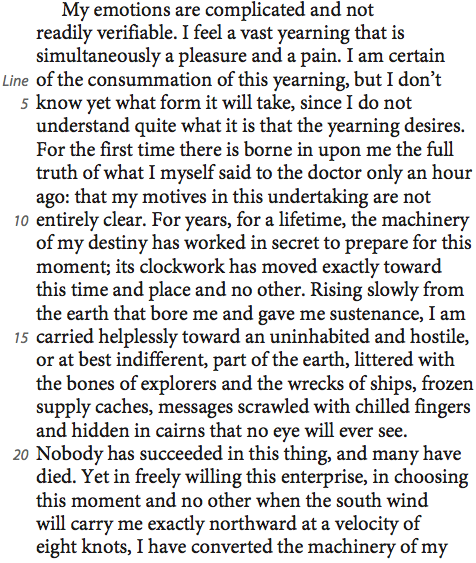
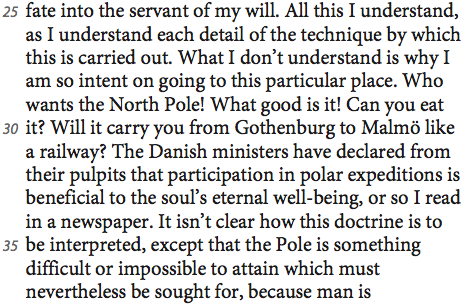
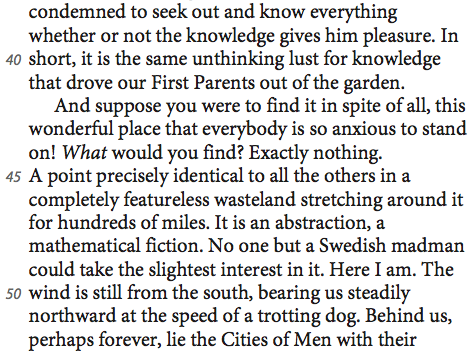
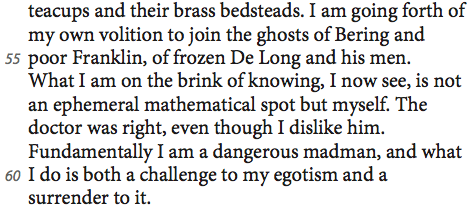
1. Over the course of the passage, the narrator’s attitude shifts from
2. Which choice best describes the narrator’s view of his expedition to the North Pole?
3. The question the narrator asks in lines 30-31 (“Will it . . . railway”) most nearly implies that
Answer key (scroll down when ready):
1. C 2. B 3. D
In Conclusion
- Inference questions ask you to deduce, speculate, and examine based on evidence directly stated in the text.
- In order to successfully answer inference questions, you must make sure you understand the question
- Look for context to help if the lines/words mentioned in the question aren’t enough
- Answer the question in your own words before looking at the Exam’s answer choices
- Nail down other Exams Reading skills to help you with inference questions
- Answer questions in an order that makes sense and is not confusing/disorienting
- Eliminate three wrong answers
Reading inference questions on the Exams ask you about information that’s implied by the passage rather than directly stated. These questions test your ability to draw conclusions using evidence that appears in the passage. For inference questions, you’re normally required to do one of these four things:
-
Identify a logical consequence of a statement or of two statements taken together
-
Infer the intended meaning of a word that’s used figuratively in the passage
-
Determine the author’s attitude toward the passage’s topic or subtopics
-
Infer from attitudes portrayed in the passage how the author or others feel about different theories or events
For instance, suppose you read a passage that compares the rapidity of wing beats between houseflies and horseflies. Information in paragraph two may state that the wings of horseflies beat at 96 bps (beats per second). Information in paragraph four may say that a Purple Winger is a type of horsefly.
From this information, you can infer that the wings of the Purple Winger beat at a rate of 96 bps. This is an example of the first bullet in the preceding list: recognizing a logical consequence of the author’s statements.
The horsefly conclusion doesn’t require that you make great leaps of logic. When you’re answering an inference question, look for the choice that slightly extends the passage’s meaning. Choices that go beyond the passage’s scope are usually incorrect. Don’t choose an answer that requires you to assume information that isn’t somehow addressed by the passage.
As you read the passage, look for clues to the author’s tone as well as his or her purpose. You’re bound to see questions that ask you to gauge how the author feels about the topic. Tone and style questions commonly ask you to figure out the author’s attitude or complete the logical flow of the author’s ideas.
The author may be neutral, negative, or positive and may have different attitudes about different types of information within the same passage. It’s up to you to determine the nature and degree of the author’s feeling from the language used in the passage. With practice, you’ll figure out how to distinguish between an enthusiastic author and one who’s faking enthusiasm to mock the passage’s subject.
When making determinations about the author’s style and tone, consider the passage as a whole. You may find one or two examples of praise in an article that’s otherwise overwhelmingly critical of a subject.
Don’t make the mistake of quickly categorizing the passage from a few words that happen to catch your attention. Instead, determine the passage’s main idea and the author’s purpose (you need to do this to answer other questions, anyway), and use that information to help you discern the author’s style and tone.
For example, if an author’s purpose is to argue against a particular point of view, critical words regarding the proponents of that viewpoint reveal an overall critical attitude. However, you wouldn’t say the same about an author of a passage that supports a viewpoint overall but includes one or two criticisms of some supporters of the viewpoint.
Style and tone questions may point you to a specific portion of a passage, or they may be about the whole passage. Even if a question does reference a specific part of the text, it does so in relation to the passage as a whole.
For example, you can usually answer a question that asks you why an author chose to use certain words in a particular sentence only within the context of the entire passage. So if you know the main idea, author’s purpose, and tone of the entire passage, you should be able to effectively deal with questions about the use of a particular word or phrase in one part of the passage.
The Exams primarily tests your logical reasoning ability, so expect to see a lot of inference questions in the reading comprehension section. They’re easily recognizable because they usually contain infer, suggest, or imply in the question, such as these examples:
-
It can be inferred from the passage that the Western concept of “need” differs from other definitions of need in which one of the following ways?
-
Information in the passage implies that which one of the following is often the subject of Neruda’s poetry?
-
The author’s stance toward the Western concept of “need” can best be described as
-
The author brings up southern migration patterns most likely to suggest which one of the following?
Sometimes knowing a great deal about a passage’s topic can be a detriment because you may be tempted to answer questions based on your own knowledge rather than the passage itself. Simply answer the questions as they’re asked, and make inferences that can be justified by information in the passage.
Practice Set On Passage & Paragraph Inference
Answer: (e)
The movie had been used just as an example of how repeated interactions acquaint us with a fuller meaning.
Answer: (b)
Could even have been ‘definitely true’.
Answer: (a)
2nd last paragraph clearly shows that.
Q4. The advice is being given to the sales team.
Answer: (c)
It could be given to any individual or any business team.
Q5. The author watches most movies more than twice.
Answer: (d)
Note the tone in “Have you ever seen … ?”
Answers



